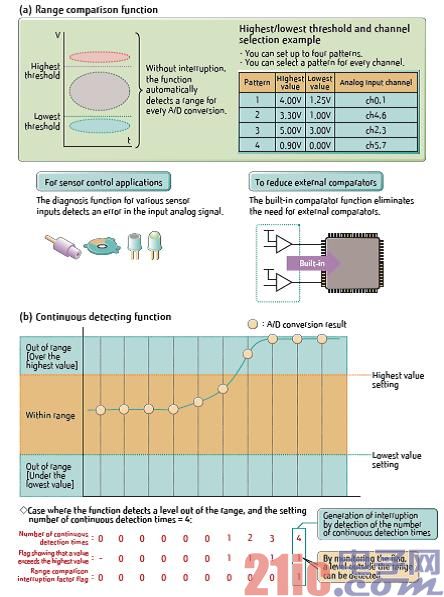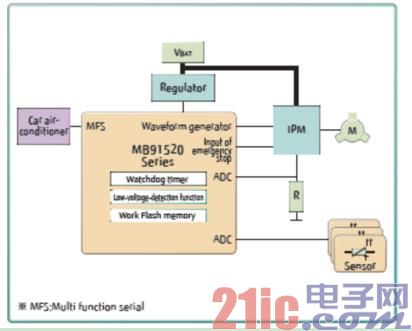As global warming continues, the automotive industry needs to produce more environmentally friendly and fuel-efficient cars. Demand for luxury cars with improved safety and comfort is increasing in developed countries, while there is also a strong demand for compact cars in rapidly developing countries such as China, India and Brazil.
In response to these demands, many automakers are promoting platform design for body control applications. Accordingly, microcontrollers (MCUs) that are easily integrated into these platforms are also needed. To meet these demands, Fujitsu Semiconductor has introduced the MB91520 series, enriching its 32-bit microcontroller FR81S family. The new series offers a variety of pin configurations and memory capacities, provides many peripheral functions for body control applications, and built-in cost reduction functions as standard features, thereby providing a most suitable platform solution. Dedicated timers for brushless DC motors and safety functions can also support AUTOSAR.
Fujitsu Semiconductor has launched the MB91520 series of the FR81S family lineup for body control with 60 new device models. This new automotive 32-bit microcontroller product line provides an optimally suited body control platform.
Extensive body control functions
The product lineup of this series is very rich. In order to meet the various needs of the automotive industry, Fujitsu Semiconductor's 60 models include packages ranging from 64 to 176 pins, flash memory from 320 to 1,088KB, and support for subclock. Various peripheral functions help load body control functions mainly for body control modules (BCM). This lineup is more powerful than the FR60 family MB91460 series for body control. Compared with the conventional FR60 family, the CPU performance of the new products has increased by more than 30% due to improved pipeline processing and internal bus operation.
In addition, the new MCU can access flash memory without waiting time, even when running at 80MHz. Other high-performance functions, such as a dedicated floating-point operation (FPU) embedded unit, support automatic code creation in the model library design phase. The complete product lineup supports a variety of application development.
The new products support a range of peripheral functions suitable for body control applications, such as a multi-function serial interface that allows flexible connection to a variety of external devices, a 12-bit A/D converter that enables advanced sensor input, and a controller area network (CAN) that supports up to 128 messages.
The device's multifunctional serial interface can flexibly connect various external devices to achieve a wide range of body control communication methods. In order to flexibly support these communication systems, the product provides a multifunctional serial interface as shown in Figure 1. UART, SPI, LIN and I2C are software selectable for each channel. Up to 12 channels can be loaded in the industry, which is the highest level in the industry.

A/D converter supports advanced sensor input
The high-resolution 12-bit A/D converter loaded on the product can support sensors and peripheral components, providing improved technical advantages. Since two A/D converter units are loaded, simultaneous conversion can be achieved. As shown in Figure 2(a), the range comparison function can detect a given range level integrated as a hardware function. The highest and lowest thresholds compared with the A/D conversion value can be set in advance. When the level is within or outside the predetermined range, the function automatically detects, thereby reducing the software load. Moreover, as shown in Figure 2(b), continuous comparison can be achieved.

Figure 2: Overview of the A/D converter range comparison function
Other advanced features
Many new cars are equipped with electronic control units (ECUs) connected via CAN. Networks are becoming larger due to the increase in the number of nodes and other factors. Fujitsu Semiconductor's previous 32-bit microcontrollers typically had a cache of 32 messages. The new product's cache can hold up to 128 messages, making it possible to support systems with more nodes. The supported CAN protocol is Version 2.0A/B.
In addition, the built-in E2PROM, watchdog timer IC and reset IC and other external components can reduce the number of components and board mounting space, reducing the total system cost. Since the product has 64KB data flash (working flash) in addition to the program flash, no external E2PROM is required. Moreover, the data flash embedded in the microcontroller prevents information leaks. The built-in CR oscillation circuit system operates the hardware watchdog timer independently of the main clock. No external watchdog timer IC is required.
Since this product has a low voltage function that monitors the external power supply, there is no need to load an external reset IC on the board. 11 voltage levels can be selected by software. The waveform generator can be used as a dedicated timer to support brushless DC motors, and it can output a three-phase waveform. In order to support brushless motor operation, a dead time setting function and an emergency stop function are required.
Figure 3 describes the diagnostic functions of the product, such as the CPU self-diagnostic program, bus error detection function, RAM self-diagnostic function, memory error detection and correction (ECC), and I/O port protection function. [page]
Functional Safety for Microcontrollers

Figure 3: MB91520 Series Diagnostic Functions
Application Examples
Based on the switches and sensors installed in the vehicle and the information obtained from other ECUs, BCM controls the interior lighting, turn signals, wipers, door locks, side mirrors and other items. The product has up to 12 channels of multi-function serial interface and three-channel CAN, which can flexibly connect multiple devices and ECUs. The A/D converter provides up to 48 channels to support various input processing from sensors. Figure 4 describes the application example of BCM.

Figure 4: Application example of BCM
As an example of BCM application, electric compressors have recently been used in car air conditioners. To maintain comfort inside the car, the temperature must be accurately controlled. Control is achieved using a waveform generator to control the brushless DC motor, which in turn runs the air conditioner's electric compressor. Figure 5 describes an example of an electric compressor application.

Figure 5: Application example of electric compressor
In summary, the MB91520 series is compatible with AUTOSAR R3.1/4.0, and can use a seamless integrated development environment for 16-bit and 32-bit microcontrollers, as well as an emulator (MB2100-01-E) that supports single-line on-chip debugging. All chips in the new product line are equipped with program flash and separate data storage flash. This reduces the need for external E2PROM and simplifies system development, making it suitable for peripheral functions in automotive ECU systems.
Previous article:Design of automobile rearview mirror control module based on LIN bus
Next article:Design of dual-drive electric vehicle control system based on LPC2132
- Popular Resources
- Popular amplifiers
- Learn ARM development(16)
- Learn ARM development(17)
- Learn ARM development(18)
- Embedded system debugging simulation tool
- A small question that has been bothering me recently has finally been solved~~
- Learn ARM development (1)
- Learn ARM development (2)
- Learn ARM development (4)
- Learn ARM development (6)
 Professor at Beihang University, dedicated to promoting microcontrollers and embedded systems for over 20 years.
Professor at Beihang University, dedicated to promoting microcontrollers and embedded systems for over 20 years.
- LED chemical incompatibility test to see which chemicals LEDs can be used with
- Application of ARM9 hardware coprocessor on WinCE embedded motherboard
- What are the key points for selecting rotor flowmeter?
- LM317 high power charger circuit
- A brief analysis of Embest's application and development of embedded medical devices
- Single-phase RC protection circuit
- stm32 PVD programmable voltage monitor
- Introduction and measurement of edge trigger and level trigger of 51 single chip microcomputer
- Improved design of Linux system software shell protection technology
- What to do if the ABB robot protection device stops
- Analysis of the application of several common contact parts in high-voltage connectors of new energy vehicles
- Wiring harness durability test and contact voltage drop test method
- From probes to power supplies, Tektronix is leading the way in comprehensive innovation in power electronics testing
- From probes to power supplies, Tektronix is leading the way in comprehensive innovation in power electronics testing
- Sn-doped CuO nanostructure-based ethanol gas sensor for real-time drunk driving detection in vehicles
- Design considerations for automotive battery wiring harness
- Do you know all the various motors commonly used in automotive electronics?
- What are the functions of the Internet of Vehicles? What are the uses and benefits of the Internet of Vehicles?
- Power Inverter - A critical safety system for electric vehicles
- Analysis of the information security mechanism of AUTOSAR, the automotive embedded software framework
- May I ask if Mr. Yi Zhongtian mentioned in a certain program that he talked about "have you learned it?", "have you learned it thoroughly?", "have you learned it thoroughly?", in which program did he say this?
- PCB file conversion
- 5G indoor base stations will be released soon, and it is expected that each household will have a small base station, which will subvert the existing home Internet access methods.
- How to consider the impact of audio analog signals after being transmitted through a 100m long cable?
- Angle sensor
- Transistor Selection
- Fancy PCB Exhibition (1)
- Why is it said that 90% of EMC is designed? (Long article)
- Chinese mobile phones continue to sell well in India, Vivo surpasses Samsung to become the second largest brand
- Share CC2541 Bluetooth learning about ADC

 UA747HCQM
UA747HCQM
















 京公网安备 11010802033920号
京公网安备 11010802033920号